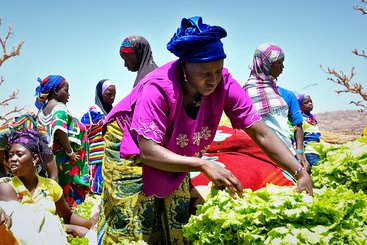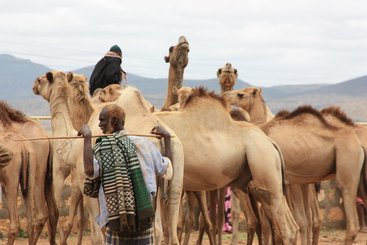Welcome back to the 1970s. Most readers will be too young to remember how different that decade was – not because of its dodgy fashion, a global financial crisis or a US president mired in scandal and corruption. No, the 1970s was the decade before Prof. Amartya Sen.
In the 1970s, people spoke about food security as a national—level characteristic. It was defined as the “availability …of adequate world food supplies of basic foodstuffs to sustain a steady expansion of food consumption and to offset fluctuations in production and prices” at the World Food Conference in 1975. Famines? They were just more extreme cases of insufficient food. And then came Prof. Sen.
Famines, he showed us, didn’t arise because there was no food – but because some people couldn’t get food. Food security suddenly became about people, understanding how they get their food and ensuring that they can always get enough. Whole new ways of analysing food security in crises were opened up, and new ways of supporting people, too. Here was the key that allowed us to move from throwing sacks of maize out of the back of planes, to predicting food crises and supporting social protection programmes and making monetary payments to the poor so they can buy their own food in the market. A lot of people owe their survival to this transformation. Very many more owe their increased agency, greater resilience, better livelihoods and improved dignity.
With Prof. Sen to guide us, we could also look more closely at famines. Once we knew to see them as a situation where (some) people were excluded from food, the focus of attention could move from the food itself, to looking at the barriers that kept people away from food. Poverty often plays a role, but though poverty regularly causes hunger and widespread malnutrition, it takes something else to create a famine. There has to be a willingness to see huge numbers of people die. That is why Prof. Sen famously said that famines cannot occur where there is a democracy and a free press – though food insecurity can and does thrive in such places. Famines occur mostly through war, but always when one powerful authority, whether by sin of commission or omission, allows people to die for want of food.
It sometimes seems that since the renewed invasion of Ukraine by Russia in 2022, all that knowledge, all that rich understanding, has been thrown in the bin. We increasingly see the frankly bizarre sight of the aid sector picking up where it left off in the 1970s. Food insecurity in the world suddenly became all about wheat from Ukraine, even in countries where wheat wasn't eaten (a lot of Africa), local food prices never moved in line with world grain prices (many landlocked countries) and where the reasons that people were hungry were more about conflict, landlessness, poverty and/or gender inequality (pretty much everywhere). In a pre-Sen world, it appeared to make sense if we held complete discussions about how to end food security crises without mentioning poverty, inequality, broad based economic growth, land reform or gender equality. Now, hunger is increasingly being used – “weaponised” as someone said to me recently – to distract attention (and resources) away from all the difficult and structural things that need to change to prevent poverty, and towards the simple solution of food and calorific intake.
And in a pre-Sen world, it appeared to make sense to think of famines as being different from food insecurity only in their degree, not in their very nature. But time and again, we are seeing conversations, initiatives and envoys addressing ‘food insecurity and famine’ all in one breath.
Will the Global Food Summit also fall in the mistakes of the past?
The UK is about to host a Global Food Security Summit on ‘Towards Zero Hunger and Ending Malnutrition’: goals which I am sure all readers endorse. While it might have been useful to start by looking at lessons from the last global initiatives to end food crises under Kofi Annan and Ban Ki-moon, it is good nonetheless to see nutrition given this prominence. (Although it was somewhat surprising to see that the main question asked is ‘how to shift the dial from treatment to prevention?’ – did I just dream the huge efforts being made to prevent malnutrition under Scaling Up Nutrition over the past decade and more?).
But in the Summit agenda, too, there are signs of the pre-Sen world asserting itself. One of the four ‘action pillars’ is called “Anticipating and preventing famine and food security crises”, as if the same medicine that can treat food insecurity will also prevent famines. That can’t be the case. If those medicines worked, there wouldn’t be any famines! The global aid sector may have a lot wrong with it, and the international humanitarian system has its share of failings, but it is very good at stopping lots of people from dying. When mass mortality does occur (such as in Somalia 2011, Tigray 2022), that’s usually because at least one warring party has prevented people from reaching the assistance that they need. Dealing with that is a huge political challenge, not one that can be addressed by learning the lessons from ‘early response’ to food crises. Putting food insecurity and famine into the same discussion risks leading to a combined analysis of the solutions, or of solutions from one dominating the whole discussion, when very different kinds of measures are needed for each. The humanitarian sector is putting a lot of faith in the ability of anticipatory action to prevent crises. I've written elsewhere that I am somewhat more cautious than some in my optimism of its potential to help in difficult crises– but it would be a mistake of a different order, indeed a dangerous fallacy, to think of famines as the kinds of events that can be headed off by a few anticipatory action projects.
I hope the Summit leads to something. Its agenda is huge, encompassing everything from new agricultural technologies to aid modalities, the need for transforming global food systems in the face of climate change to ending malnutrition. The agenda has to be huge, because so much has to change if we are to end world poverty and prevent the impacts of conflicts and crises from becoming severe. If the Summit uses this huge canvas to map out the major transformations that are needed and how they need to relate to each other, that will be progress. But if the canvas becomes filled in by those wielding the Food brush, leaving no spaces for talking separately about famines and about all the other ways that conflicts lead people into crisis, that would be the triumph of anti-Sen. Retro-fashion and nostalgia are fine, but that's not something I want to see resurrected.



